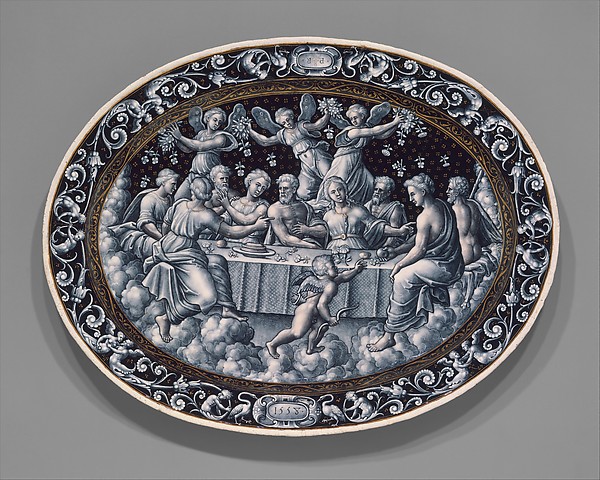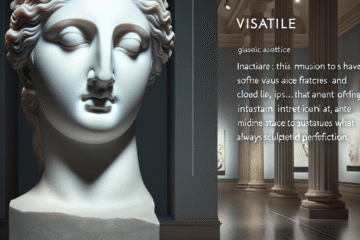
Image title: The Wedding Feast of Cupid and Psyche
Medium: Painted enamel on copper, partly gilt
Date: 1558
Source:
The Met Collection
Introduction: Shimmering Devotion and the Touch of Desire
In the cool chapels and candlelit alcoves of medieval Europe, there flickered not only the light of religious devotion but also the glimmer of another kind of allure — the sensual allure of enamel. Limoges, a city nestled in the heart of France, became a nexus for this dalliance between piety and sensuality. From the twelfth through the fourteenth centuries, artists there crafted elaborate devotional objects whose glowing surfaces and intricate figures married spirituality with something more tactile, more intimate. This article explores how Limoges enamel — technically dazzling and visually arresting — gave religious art a sensuous, almost erotic quality, awakening sight and touch alike.
Chapter One: The Birth of Limoges Enameling — Fire and Faith
Limoges enameling began in earnest in the 12th century, when the city’s artisans mastered the art of champlevé — a technique that involved incising metal surfaces (typically copper) to be filled with vibrant glass paste and then fired to a glossy finish. Driven in part by ecclesiastical patronage, this technique allowed Limoges to become Europe’s premier center for enameling. Initially, these enamel works were mainly liturgical: reliquaries, crosses, plaques for book covers — each object a glowing testament to divine inspiration. Yet even in this early phase, something palpable and corporeal shimmered beneath the holy depictions.
The technological miracle of translucent colored glass fused onto metal created optical depth—a seductive illusion of softness or moisture on cold, hard surfaces. Skin acquired a warm sheen, eyes a moist twinkle, and drapery a fluidity that nodded toward a carnal reality typically absent from Romanesque sculpture. These were holy objects, yes, but ones that seduced viewers into contemplation through touch and sight.
Chapter Two: The Human Form and the Sacred Erotic
By the 13th century, the figure became central to Limoges enamel. Smaller religious objects designed for private devotion demanded more personal, emotionally resonant imagery. In this context, the Virgin Mary, Christ, and the saints became more than symbols; they became figures suffused with pathos and sensual presence. This period saw the rise of what might be called the sacred erotic: representations of Christ on the cross with elongated limbs and exposed torsos, where suffering met bodily beauty. The televisual shimmer of enamel emphasized these contours with lavish care.
Medieval theology didn’t necessarily shy away from this. Thinkers like St. Bernard of Clairvaux often emphasized the sensual relationship between soul and Savior, especially in contemplative readings of the Song of Songs. In this spiritual climate, the physical depictions embedded in enamel works were not mere decoration; they were invitations to empathetic identification, to feeling the divine in profoundly bodily terms — an aesthetics of intimacy as devotion.
Chapter Three: A Feminine Aesthetic — The Virgin, the Unicorn, and the Flesh Made Glass
The rise of Marian devotion brought with it iconographies laden with feminine and erotic subtexts. Limoges enamels of the Immaculate Conception or the Annunciation often employed luminous blues and delicate skin tones rendered in pinks and whites, echoing the soft touch of ivory sculpture while achieving something more fluid and jewel-like. In such works, Mary becomes a symbol both inaccessible and intimately close — a paradox mirrored in the surreal tactility of enamel itself.
In some cases, enamel artists flirted with allegorical themes — such as the unicorn (frequently associated with virginity) — that had implicit erotic meanings. These sensual narratives were made more potent by the way enamel played with light. Figures emerged and vanished depending on the viewing angle, skin seemed to glow from within, and fabric whispered over limbs with an almost liquid grace. These effects weren’t careful accidents; they were the intimacy of glass and fire, crafted to whisper sacred secrets in a visual language entirely their own.
Chapter Four: Enamel in a Changing World — Decline and Rebirth
By the late 14th century, the fortunes of Limoges enameling began to wane as painted altarpieces and sculpture gained prominence. Yet even as production declined, the legacy of these sensual surfaces lived on. Limoges techniques found echoes in Renaissance enamel painting on copper — as seen in works from the 16th-century Limoges school that were prized across Europe. During this period, enamel became more overtly decorative, with secular subjects, courtly romance, and mythological scenes vying with religious inspiration. The erotic undercurrents, once veiled in theological metaphor, became more explicit in these later works.
Moreover, as enamel began to share space with painting and sculpture, it influenced how artists thought about surface and sensation. The fascination with optical play — with how texture can suggest flesh or fabric, emotion or ecstasy — persisted in Western art. Limoges had sparked a conversation about materials and meaning that would echo into modernity.
Chapter Five: Modern Parallels — From Medieval Glow to Digital Seduction
Contemporary artists exploring digital media and augmented reality often grapple with questions remarkably similar to those faced by Limoges enamelers: how to create surfaces that are not merely seen but felt, how to translate emotion into image through texture and light. In a strange turn, materials like enamel — once at the technological frontier — now appear alongside pixelated screens, mirrors, or LEDs in modern installations that simulate (and stimulate) the senses.
In this new context, the ‘erotics’ of enamel lives on not just in its materials but in its intent. Both medieval and modern works ask: When does an image touch us? When does vision slip into reverie, or even desire? The glowing saints of Limoges, with their dripping gold and lambent eyes, continue to whisper across time — a reminder that art’s surface is never merely superficial, but often the portal to deeper emotional and spiritual experience.



